
Organic reaction mechanisms. 1998 / 15
.pdf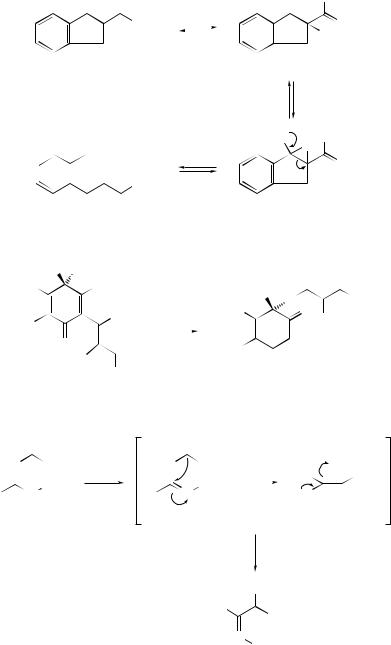
15 Molecular Rearrangements |
547 |
O |
O |
|
|
|
O |
OMe |
|||||||
|
|
|
|
|
|
|
|
|
|
|
|
|
|
|
|
|
|
|
OMe |
|
base |
O− O |
|||||
|
|
|
|
|
|
|
|
|
|
|
|
||
|
|
|
|
|
|
|
|
|
|
|
|
|
|
(173) |
|
|
|
|
(174) |
|
|||||||
|
O |
||||
|
|
|
O |
||
|
|
|
|||
|
|||||
|
|
|
|
|
|
|
|
|
|
|
|
|
|
|
|
|
|
|
|
|
O |
||
|
(176) |
|
|
||
Me |
OH |
||||
MeO |
|
|
OH |
||
O
Me
O
Me
Me
(177)
O CO2R
LTMP
 Ar RF N
Ar RF N
(179)
O− |
OMe |
|
O |
|
O |
OMe
|
|
|
|
|
|
(175) |
|
|
|
||
|
|
|
|
|
|
|
|
O |
|
|
|
|
|
|
|
Me |
|
O |
|
|
|
Me |
|
|
|
|
|
|
|
|
|||||
|
|
|
MeO |
|
O |
|
|||||
|
Na2CO3 |
|
|
Me |
|
||||||
|
|
|
|
|
|
|
|
|
|||
|
|
|
|
|
|
|
|
|
|||
|
|
|
|
|
|
|
|
|
|
|
|
|
|
|
|
|
|
|
|
|
|
|
|
|
|
|
Me |
|
|
|
|
|
|
||
|
|
|
|
|
|
|
|
|
|||
|
|
|
|
|
|
|
|
|
|
|
|
|
|
|
|
|
|
O |
|
|
|
|
|
|
|
|
(178) |
|
|
|
|
||||
|
|
− |
Li+ |
|
|
|
|
|
|
||
|
|
|
|
|
|
|
|
|
|
|
|
|
O |
|
CO2R |
|
|
RF |
O |
CO2R |
|||
|
|
|
Ar |
|
|
|
|
|
|||
RF |
N |
|
|
|
−N |
|
|
||||
|
|
|
|
|
|
|
|||||
|
|
|
|
|
|
|
Li+ |
|
|
|
|
Ar
OH
RF
CO2R
N
Ar
(180)
SCHEME 64
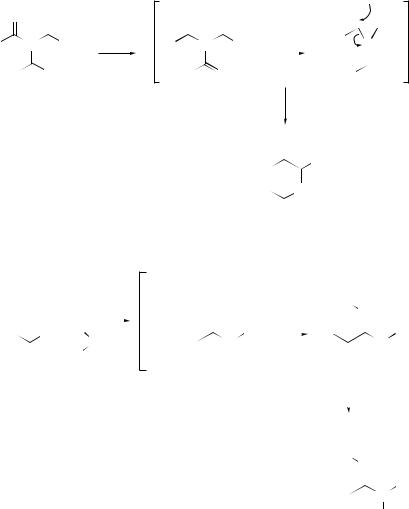
548 |
Organic Reaction Mechanisms 1998 |
O
R1 N R3
R2  O
O
O |
|
BuLi |
||||
|
|
|
|
|||
|
|
|
|
|
||
(RO)2 |
|
|
R1 R2 |
|||
P |
||||||
|
|
|
|
R3 N |
|
CN |
|
|
|
|
|||
O−
O
|
|
|
|
− |
|
R1 |
N R3 |
R1 |
N |
R3 |
|
||||
R2 |
|
O |
|
R2 |
|
||
|
|
|
|
|
|
|
O |
|
|
|
|
|
|
|
|
|
||||
|
|
|
|
|
|
R1 |
|
|
|
|
R3 |
|
|
|
|
|
|
|
|
|
|
|
|
|
|
|
|
|
|
|
|
|
|
|
|
|
|
||||
|
|
|
|
|
|
|
|
|
|
|
|
|
|
|
|
|
|
|
|
|
|
|
|
|
|
|
R2 |
|
|
|
NH |
|
|
|
|
|
|
|
|
|
|
|
|
|
|
|
|
|
|
|
|
|
|
|
|
|
|
|
|
|
|
|
|
|
|
|
|
|
|
O |
|
|
|
|
|
|
|
|
|
||||
SCHEME 65 |
|
|
|
|
|
|
|
|
|
|
|
|
|
|
||||||
|
|
|
|
|
|
|
|
|
|
|
|
O |
|
|
|
|
|
|||
|
|
|
|
|
|
|
|
|
|
|
|
|
|
|
|
|
||||
|
N− |
|
|
|
|
(RO)2 |
|
|
|
|
|
|
|
|
||||||
O |
|
|
|
P |
N |
|||||||||||||||
|
|
|
|
|
|
|
|
|
|
|
|
|
|
|
|
|||||
|
|
|
|
|
|
R2 |
|
|
|
|
|
1 |
|
|
|
|
|
|
R2 |
|
(RO)2P |
|
|
|
|
R |
|
|
|
|
|||||||||||
|
|
N |
|
|
|
|
− |
|
|
N |
||||||||||
|
|
|
|
|
|
|
|
|
|
|
|
|||||||||
|
|
R1 |
|
|
|
|
|
|
|
|
|
|
|
|
|
|
|
|
|
|
|
|
|
|
R3 |
|
|
|
|
|
|
|
|
|
|
|
R3 |
|
|||
|
|
|
|
|
|
|
|
|
|
|
|
|
|
|
|
H3O+ |
||||
|
|
|
|
|
|
|
|
|
|
|
|
|
|
|
|
|||||
|
|
|
|
|
|
|
|
|
|
|
|
O |
|
|
|
|
|
|||
|
|
|
|
|
|
|
|
|
|
|
(RO)2 |
|
|
|
|
|
|
|
||
|
|
|
|
|
|
|
|
|
|
P |
N |
|||||||||
|
|
|
|
|
|
|
|
|
|
|
|
|
|
|
|
|||||
|
|
|
|
|
|
|
|
|
|
|
|
1 |
|
|
|
|
|
|
R2 |
|
R
N
R3
(181)
SCHEME 66
ketones.300 A possible mechanism for the transformation is outlined in Scheme 65. A new type of [1,2]-rearrangement of a toluenesulfonyl group from nitrogen in azoles to the neighbouring carbon has been initiated301 by treatment with n-butyllithium. N -Phosphorylated amidines (181) have been synthesized302 by the reaction of lithiated alkyl phosphonates with N,N-dialkylcyanamide via an unprecedented carbon- to-nitrogen migration of the phosphoryl group (see Scheme 66). A novel electrophilic rearrangement involving the migration of an alkoxycarbonyl group from carbon to a nitrogen anionic centre has been reported.303

15 Molecular Rearrangements |
549 |
Recent applications of the Favorskii rearrangement have been reviewed.304 A PM3 semiempirical study has been undertaken of the molecular mechanism for the Favorskii rearrangement of α-chlorocyclobutanone. The results indicated that, although two competitive reaction mechanisms can exist, viz. the semibenzilic acid and the cyclopropanone rearrangement, the former appears to be the energetically favorable pathway in vacuo and in solution.305 Electrochemically reduced polyhalo ketones have been found to react with amines and phenols to afford the corresponding α, β-unsaturated amides and esters in an electrochemically induced Favorskii rearrangement.306 A variety of iridolactones have been synthesized using a stereoselective Favorskii rearrangement as the key step.307 α-Hydroxy ketones have been prepared from the corresponding α-nitro ketones under aqueous basic conditions by a novel transformation which has been explained308 by a double SN2 reaction which proceeds via a Favorskii-like cyclopropanone intermediate. 3-Methoxycarbonyl- 1,5-anhydro-β-D-erythro-pentafuranose (183) has been obtained309 by a tandem elimination–Favorskii rearrangement by treating 2,3,4-tri-o-tosyl-1,6-anhydro-β-D- glucopyranose (182) with sodium methoxide (see Scheme 67).
Silyl enol ethers have been prepared310 via a Brook rearrangement from the reaction of phenyldimethylsilyllithium with α-silyloxy ketones (see Scheme 68). The comparison of the rate of the base-catalysed Brook rearrangement in β-substituted
|
O |
|
|
|
|
|
O |
|
|
|
|
|
|
O |
|
|
O |
||||
|
O |
NaOMe |
|
|
|
O |
|
|
O |
|
O |
||||||||||
|
|
|
|
|
|
|
|
|
|
|
|
|
|
|
|
|
|
|
|||
TsO |
|
|
OTs |
|
|
|
|
TsO |
TsO |
|
|
|
− |
|
|
|
|||||
|
|
|
|
|
|
|
|
|
|
|
|
|
|||||||||
|
|
|
|
|
|
|
|
|
|||||||||||||
|
|
|
|
|
|
|
|
|
|
|
|
|
|
|
|
|
|
|
|
|
|
|
OTs |
|
|
|
|
|
OTs |
|
|
O |
|
O |
|||||||||
|
(182) |
|
|
|
|
|
|
|
|
|
|
|
|
|
|
|
|
|
|
|
|
|
|
|
|
|
|
|
|
|
|
|
|
|
|
|
|
|
|
|
|
|
|
|
|
|
|
|
|
|
|
|
|
|
|
|
|
|
|
|
|
|
|
|
O |
|
|
|
|
|
|
|
|
|
|
|
|
|
|
|
|
|
|
|
|
|
|
|
|
|
|
|
|
|
|
|
|
|
|
|
|
|
|
|
|
|
|
O |
|
|
|
|
|
|
|
|
|
|
|
|
|
|
|
|
|
|
|
|
MeO2C |
||
|
|
|
|
|
|
|
|
|
|
|
|
|
|
|
|
|
|
|
(183) |
||
|
|
|
|
|
|
|
|
|
|
SCHEME 67 |
|
|
|
|
|
|
|
|
|
|
|
|
O |
|
|
|
|
|
PhMe2Si O− |
|
|
|
|
|
|
|
|
|
|
||||
|
R |
|
|
|
|
PhMe2SiLi |
|
|
|
|
|
|
|
|
OSiMe2Ph |
||||||
|
|
|
|
|
|
R |
|
|
|
|
|
|
|
||||||||
|
|
R |
|
|
|
|
|
|
|
|
|
|
|
|
|||||||
|
|
|
|
|
|
|
|
|
R |
|
|
|
|
|
|
R |
R |
||||
|
OSiMe3 |
|
|
|
|
|
OSiMe3 |
|
|
|
|
|
|
|
|||||||
|
|
|
|
|
|
|
|
|
|
|
|
|
|
|
|
||||||
|
|
|
|
|
|
|
|
|
|
SCHEME 68 |
|
|
|
|
|
|
|
|
|
|
|
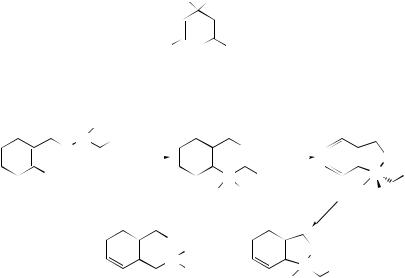
550 |
Organic Reaction Mechanisms 1998 |
α-silylallyl alcohols (184) has been used311 |
as a tool for the assessment of the |
α-carbanion-stabilizing ability of the β-substituent. 3-Trimethylsilylprop-2-yn-1-ol has been prepared312 from 1-trimethylsiloxy-3-bromomagnesiumprop-2-yne by an unusual 1,4-migration of the trimethylsilyl group from oxygen to carbon, and a recent approach to the C(33)–C(38) fragment of amphotericin B and nystatin has involved a retro-(1,4)-Brook rearrangement and the stereoselective manipulation of the resulting allylsilane.313 Treatment of 3-[(silyloxy)methyl]furans and thiophenes with n-butyllithium has provided314 2-silylated-3-(hydroxymethyl)furans and thiophenes via an intramolecular 1,4-oxygen to carbon silyl migration, and a new method which involves the regioselective lithiation of various 2-silylated-3-(hydroxymethyl)furans has been described315 for the preparation of 2,4- and 3,4-disubstituted furan rings. Treatment of chloromethylsilane (185) with t -butyllithium has been shown to yield oxasilacyclopentane (188), believed to arise via rearrangement of γ -oxidosilane (186), followed by methyl migration.316 Aryl migration would have given oxasilacyclohexane (189). The preference for methyl migration in (185) suggests that migration is favoured by an apical position of the migrating group in a trigonal bipyramid intermediate (187).
Recent applications of the Ramberg–Backlund¨ rearrangement to the synthesis of bioactive target molecules have been reviewed.317 Under Ramberg–Backlund¨ conditions, exo-6-bromo-syn-7-bromo(chloro)methylsulfonyl-endo-6-phenylbicyclo[3.1.1]- heptane has been shown to yield anti-6-hydroxy-7-methylene-syn-6-phenylbicyclo- [3.1.1]heptane along with 3-oxa-2-phenyl-5-thiatricyclo[4.4.0.02,7]decane S,S-dioxide, the product of an unusual heterocyclization.318 In contrast to trichloromethyl sulfoxides which undergo base-induced β-elimination of chloroform to produce
sulfines, the corresponding sulfones |
have been found to undergo an unusually |
HO |
SiMe2But |
XO OBut
OBut
(184)
X = SPh, SiMe3
Me |
Me |
|
|
|
|
|
|
|
|
|
||||
Si |
Cl |
|
|
O− |
|
|
|
|
||||||
O |
|
|
|
|
|
|
|
|
|
O |
|
|||
|
|
|
|
|
|
|
|
|
|
|||||
|
|
|
|
|
|
|
|
|
|
|
|
|
|
|
Br |
|
|
|
|
|
|
Si |
Cl |
|
|
Si |
Cl |
||
|
|
|
|
|
|
Me |
|
|
||||||
(185) |
|
|
|
|
|
Me |
Me |
Me |
|
|||||
|
|
|
|
|
|
|
|
|||||||
|
|
|
|
|
|
(186) |
|
|
|
(187) |
|
|||
|
|
|
|
O |
Me |
|
|
|
O |
|
|
|||
|
|
|
|
|
|
|
|
|
||||||
|
|
|
|
|
|
|
|
|
|
|
||||
|
|
|
|
Si |
|
|
|
|
Si |
|
|
|||
|
|
|
|
Me |
|
|
Me |
|
|
|||||
|
|
|
|
|
|
|
|
|
|
|||||
|
|
|
|
|
|
Me |
|
|
|
|
||||
|
|
|
|
|
|
|
|
|
|
|
|
|||
|
(189) |
|
|
|
|
(188) |
|
|
|
|
||||
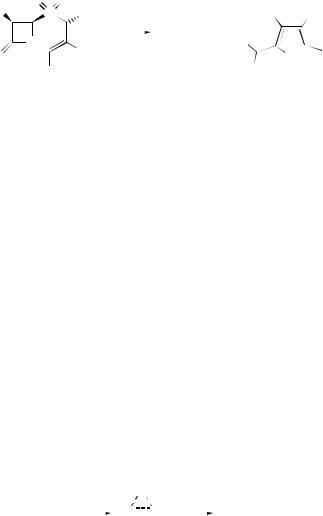
15 Molecular Rearrangements |
551 |
OO
PhOCH2CONH |
S |
Br |
|
Br |
Me |
|
N |
Me |
|
PhOCH2CONH |
CO2Me |
|
|
||||
O |
|
|
N |
||
|
CO2Me |
|
CO2H H |
|
|
|
(190) |
|
(191) |
|
|
facile Ramberg–Backlund¨ rearrangement with the formation of dichloromethylene products.319 A new route to exo-glycals, which starts from S-glycoside dioxides and utilizes a variant of the Ramberg–Backlund¨ rearrangement has been described.320 An unusual Ramberg–Backlund¨-like rearrangement followed by bromination has been invoked321 to explain the formation of a bromopyrrole derivative (191) from α-bromocephem sulfone (190) in acetonitrile solution.
Density functional theory has been used to study the rearrangement of the fulminate anion to the cyanate anion. The study has shown that the transformation proceeds via an oxazirinyl anion intermediate.322 The activation barriers of the 1,2-migrations of various groups (R) in acetylide anions [(192) → (193)] have been calculated323 with ab initio methods. The barrier for the rearrangement was found to depend on the capability of R to form a hypervalent-type bonding for which its ability to accomplish negative hyperconjugation as well as its polarizability are important. The carbanionic ring enlargement of (halomethylene)cyclobutanes to 1-halocyclopentenes has been extended to the fluoro analogues. Experiments with labelled substrates have shown that, in general, the larger the halide and the higher the reaction temperature, the greater the preference for double migration over single migration as a mechanistic pathway.324 Chemical evidence has been obtained325 for the first time to support a cyclopropane ring migration on the periphery of a cyclic polyenide, during the butyllithium-mediated rearrangement of tricyclo[5.3.1.01,7]undeca-2,4,9-triene to tricyclo[6.3.0.01,3]undeca- 5,7,9-triene, the sole product of the reaction.
R
|
|
|
|
|
C− |
|
|
|
− |
|
|
−C |
|
|
|
|
|
|
R |
|
C |
|
|
|
C |
|
|
C |
b |
|
|
C |
|
|
R |
||
|
|
|
|
|
|
|
|
|||||||||||
|
|
|
|
|
|
|
|
|
|
|||||||||
|
|
|
a |
b |
|
|
a |
|
|
|
a |
|
|
b |
|
|||
(192) |
|
|
|
|
|
|
|
|
|
(193) |
|
|||||||
A recent study has indicated326 that the skeletal rearrangement step in the B12- catalysed isomerization of methylmalonyl-CoA to succinyl-CoA occurs not by a radical pathway but by an anionic or organocobalt pathway. A computational study of the isomerization of allyl alcohol into homoallyl alcohol by lithium amide has pointed to327 a process proceeding via a transition state in which the proton is half transferred between carbon and nitrogen in a hetero-dimer. 1,1-Dilithio-2,2-diphenylethene (194), accessible from 1,1-dibromo-2,2-diphenylethene by double bromine–lithium exchange, has been found328 to undergo an intramolecular rearrangement to (E)-1-lithio-2-(2-lithiophenyl)-2-phenylethene (195), while the intermolecularity of
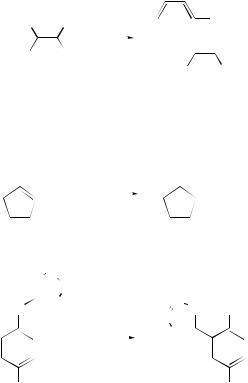
552 Organic Reaction Mechanisms 1998
the rearrangement of 3,4-dilithio-2,5-dimethylhexa-2,4-diene to the cross-conjugated 2,5-dimethylhexadienediyl anion has been established.329
A new strategy has been developed330 for the preparation of β-keto-phosphonates (197) via a halogen metal exchange-induced 1,3-phosphorus migration of 2-bromovinyl phosphates (196). The ortho-directing properties of the (aryloxy)tetrazole functionality, and the subsequent anionic 1,3-migration of ortho-lithiated (aryloxy)tetrazoles (198) to provide 5-(hydroxyaryl)-1-phenyl-1H -tetrazoles (199) have been demonstrated for the first time.331 It has been proposed332 that the base-catalysed rearrangement of 3-halocoumarins to benzofuran-2-carboxylic acids proceeds by rate-determining fission of the carbon–halogen bond following formation of a relatively unstable carbanion intermediate formed by intramolecular nucleophilic attack on the vinyl group by the phenoxide anion (see Scheme 69).
An 18O-labelling investigation of the oxygen to sulfur transposition in the basecatalysed rearrangement of o-benzoyl-N -(diphenylphosphinothioyl)hydroxylamine (200) to (201) has been undertaken.333 The labelling results are outlined in
Scheme 70 although further evidence is |
required to substantiate the mechanism |
|||||||||||||||||||
|
Ph |
|
Li |
|
|
|
|
|
|
|
|
|
|
|
|
Li |
||||
|
|
|
|
|
|
|
|
|
|
|
|
|
|
|
|
|
|
|
|
|
|
|
|
|
|
|
|
|
|
|
|
|
|
|
|
|
|
|
|
|
|
|
|
|
|
|
|
|
|
|
|
|
|
|
|
|
|
|
|
|
|
|
|
Ph |
|
Li |
|
|
|
|
Ph |
|
|
|
|
Li |
|||||||
|
|
|
|
|
|
|
|
|
||||||||||||
|
|
|
|
|
|
|
|
|
|
|
|
|
|
|
|
|||||
(194) |
|
|
(195) |
|
|
|||||||||||||||
|
O |
|
|
|
|
|
|
|
|
|
|
|
|
|
|
|
||||
|
|
|
|
|
P(OR)2 |
|
|
|
|
|
O |
|
|
|
O |
|||||
|
|
|
|
|
|
|
|
|
|
|||||||||||
|
O |
|
|
|
|
|
|
|
|
|
|
|||||||||
|
|
|
|
|
|
|
|
|
nBuLi |
|
|
|
|
|
|
|
|
|
|
|
|
|
|
|
|
|
Br |
|
|
|
|
|
|
|
|
|
P(OR)2 |
||||
|
|
|
|
|
|
|
|
|
|
|
|
|
|
|
||||||
|
|
|
|
|
|
|
|
|
|
|
|
|
|
|
|
|
||||
(196) |
|
|
|
|
|
|
|
|
|
(197) |
||||||||||
|
N |
N |
|
|
|
|
|
|
|
|
|
|
|
|
|
|||||
|
|
|
|
|
|
|
N |
|
|
|
|
N |
|
|
|
|
|
|||
|
|
|
|
|
|
|
|
|
|
|
|
|
|
|
|
|||||
|
O |
N |
|
|
|
|
N |
|
OH |
|||||||||||
|
|
|
|
|
|
N |
|
|||||||||||||
|
|
|
|
|
|
|
|
|
|
|
|
|
|
|
|
|||||
|
|
|
|
|
|
Ph |
|
|
|
|
|
|
|
|
||||||
|
|
|
|
|
|
|
|
|
|
N |
|
|
|
|
|
|||||
|
|
|
|
|
|
|
|
|
|
|
|
|
|
|
|
|
||||
|
|
|
|
|
|
|
|
|
|
|
|
|
|
|
|
|
|
|
|
|
|
|
|
|
|
|
|
|
|
|
|
|
|
|
|
|
|
|
|
|
|
|
R |
|
|
|
|
|
|
Ph |
|
|
|
|
R |
|||||||
|
|
|
|
|
|
|
|
|
|
|
||||||||||
|
|
|
|
|
|
|
|
|
|
|
|
|
|
|
||||||
(198) |
|
|
|
|
|
|
|
|
|
|
|
|
|
|
(199) |
|||||
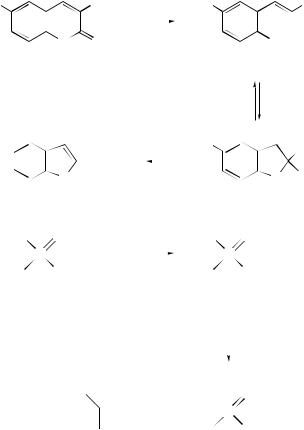
15 Molecular Rearrangements |
|
|
|
|
|
553 |
|
R |
X |
|
R |
|
|
X |
|
|
O |
O |
−OH |
|
O− |
CO2− |
|
|
|
||||||
|
|
|
|
||||
|
|
|
|
||||
|
|
|
|
|
|||
X = Br or Cl |
|
|
|
|
|
|
|
|
|
|
|
|
|
|
|
R |
|
|
X |
|
|
|
CO2− |
|
|
|
|
|
|
||
|
|
|
|
|
|
|
|
|
|
||
|
|
O |
−X− |
|
|
|
|
O CO2− |
|||
|
|
|
|
|
|
|
|
||||
|
|
|
|
|
|
|
|
|
|
||
|
|
|
SCHEME 69 |
|
|
|
|||||
Ph |
|
S |
|
base |
|
Ph |
|
O |
|||
|
P |
|
|
|
P |
||||||
|
|
|
|
|
|
|
|||||
Ph |
|
NHOC OPh |
|
Ph |
|
NHSC OPh |
|||||
|
(200) |
|
|
|
|
|
|
|
|
|
|
|
|
|
|
|
|
|
|
MeOH |
|
NaOMe |
|
|
|
|
|
|
|
|
|
|
|||
|
|
O |
Ph |
|
Ph |
|
O |
||||
|
|
|
|
||||||||
|
|
|
|
+ S |
+ |
P |
|||||
|
|
|
OMe |
|
Ph |
|
NH2 |
||||
|
|
|
|
|
|
|
(201) |
|
|||
SCHEME 70
of this unusual rearrangement. The o-mesyloxime derivatives of ringand side- chain-substituted 3-phosphonomethylcyclohexenones have been found to undergo a basic aluminium oxide-promoted Neber rearrangement to yield the corresponding vinyl aminocyclohexenonealkylphosphonates, regioselectively.334 A synthetic route involving a key Neber rearrangement has been described335 for the preparation of both [1-13C]- and [1-15N]-2-amino-4-phenylbutanoic acids.
Cationic and Related Rearrangements
A theoretical ab initio study of the interconversion of isobutonium ions has been carried out.336 The 1,1-trimethylene-1H -azulenium ion (202) has been prepared and its chemical behaviour has been shown337 to be different from that of its threemembered ring homologue. The solvolysis of 1-[trans-2-(m- or p-substituted phenyl)
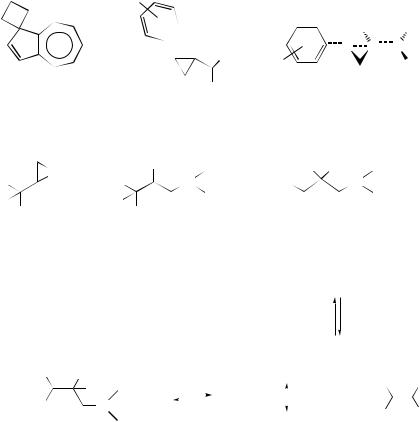
554 |
|
|
|
|
|
|
Organic Reaction Mechanisms 1998 |
||||||
|
|
X− |
|
R |
|
|
|
|
|
|
|
|
|
|
|
|
|
|
|
|
|
|
|
|
|
|
|
|
|
|
|
|
|
|
|
|
|
H |
|
|
Me |
|
+ |
|
|
|
H |
|
|
|
C C |
|
C + |
||
|
|
|
|
|
Me |
R |
|
||||||
|
|
|
|
|
|
|
|
|
|
Me |
|||
|
|
|
|
|
|
+ |
|
|
|
|
|||
|
|
|
|
|
|
|
|
|
|
|
|
||
|
|
|
|
|
|
|
|
|
|
|
|
|
|
|
(202) |
|
|
|
(203) |
Me |
|
|
(204) |
|
|
||
|
|
|
|
|
|
|
|
|
|||||
|
X = BF4, PF6 |
|
|
|
|
|
|
|
|
|
|
|
|
|
NZ |
|
|
R |
|
Ts |
|
R |
Me |
|
Ts |
|
|
|
|
|
|
|
|
|
|
|
|
||||
Me |
|
Me |
|
N |
|
Me |
|
N |
|
|
|
||
|
|
+ |
− |
|
− |
|
|||||||
|
|
|
|
|
+ |
|
|
|
|||||
Me |
R |
|
Me |
|
|
AlCl3 |
|
|
AlCl3 |
||||
|
Me |
|
|
|
Me |
|
|
|
|
|
|||
|
Me |
|
|
|
|
|
|
|
|
|
|
||
|
(205) |
|
|
(206) |
|
|
|
(207) |
|
|
|
|
|
R = Bn, Ph
Z = Ts
|
|
+ |
|
− |
|
|
|||||
Me |
Me |
|
|
|
CH2 |
|
N(Ts)AlCl3 |
|
|
||
|
|
|
|
|
|
||||||
|
|
|
|
|
|
|
Me |
|
Me |
||
+ |
Me Ts |
|
|
|
|
|
|
|
|
||
|
|
|
|
|
|
|
+ |
|
|
||
R |
N |
|
|
|
|
|
|
|
|
|
|
|
|
|
|
|
|
|
|
|
|||
|
|
|
|
|
|
|
R |
|
Me |
||
|
− |
|
|
|
|
|
|
− |
|
||
|
AlCl3 |
|
|
|
|
|
|
|
|
|
|
|
|
|
|
−CH2 N(Ts)AlCl3 |
|
|
|||||
|
(209) |
(208) |
|
|
|
||||||
cyclopropyl]-1-methylethyl p-nitrobenzoates in 80% aqueous acetone has been shown to proceed via two independent reaction pathways.338 One intermediate is the correspondent cyclopropylmethyl cation (203) and the other is the homoallylic cation (204). Aluminium-induced ring cleavage of 2-t -butyl-1-tosylaziridines (205) has been shown to yield a number of products which can be explained by invoking339 the generation of carbocations (206), which on neopentyl rearrangement afford (207) whose β-cleavage generates (208) and an alkene. The intermediate then recombines with the alkene at either double-bond carbon, resulting in reversal of the cleavage, or in a formal 1,2-shift to give (209). The mechanism of the acid-induced racemization and regioisomerization of o-methylated (S)-trans-hex-4-en-3-ol and (R)-trans-hex-3- en-2-ol has been investigated in the gas phase at pressures high enough to allow complete thermalization of the reaction intermediates. The study340 has provided a first comparative analysis of the intrinsic factors governing acid-catalysed racemization of optically active alcohols, and suggests the involvement of intramolecular
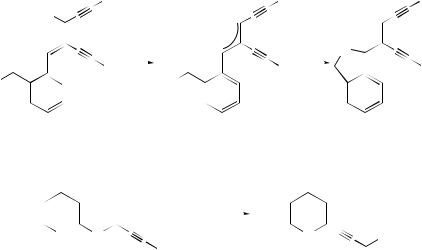
15 Molecular Rearrangements |
|
|
|
|
|
|
|
|
|
|
555 |
|||||||
|
|
|
|
|
R1 |
|
|
|
|
R1 |
|
R1 |
||||||
|
|
|
HO |
|
|
|
|
|
|
|
|
|
|
|
|
|
|
|
|
|
|
|
|
|
|
+ |
|
|
|
|
X |
|
|
||||
|
|
|
|
|
|
|
|
|
|
|
|
|
||||||
|
|
|
|
|
|
|
|
|
|
|
|
|
|
|
|
|||
RO |
|
|
|
R2 |
|
RX |
|
|
|
R2 |
|
|
|
|
|
R2 |
||
|
|
|
|
|
||||||||||||||
|
|
|
|
|
|
|
|
|
|
|
|
|
|
|||||
|
|
|
|
|
|
|
||||||||||||
|
|
|
|
|
|
|
|
|
|
|
|
|
|
|
|
|
|
|
(210) |
|
|
(211) |
|
|
|||||||||||||
|
|
|
|
|
|
|
SCHEME 71 |
|
|
|||||||||
R |
|
O |
( )n |
|
|
|
R |
|
O |
|
|
|||||||
|
|
|
|
|
|
|
||||||||||||
|
|
|
|
|
|
|
|
|
|
|
||||||||
|
|
|
|
O |
|
|
|
|
|
OH |
||||||||
|
|
|
|
|
|
|
|
|
|
|
|
|
|
|
|
( )n |
||
|
|
|
|
|
|
|
SnBu3 |
|
|
|||||||||
|
|
|
|
|
(212) |
|
(213) |
|
|
|
|
|||||||
processes and the intermediacy of two distinct hydrogen-bonded complexes, wherein the CH3OH molecule is coplanarly coordinated to the in-plane hydrogens of the 1-methyl-3-ethylallyl moiety. A good example of the control of regiochemistry associated with nucleophilic addition to allylic cations has been demonstrated.341 Thus the regio-controlled allylic rearrangement of substrates such as (210) has proved successful in the synthesis of a number of 2,5-dihydro-2-benzofuryl-cis-enediynes (211; X = O) and their sulfur analogues (211; X = S) (see Scheme 71). Stereo-controlled routes to 2,3-dihydro-4H -pyran-4-ones by the Hg(II)-catalysed rearrangement of 1-alkynyl- 2,3-epoxy alcohols in acidic media have been reported.342 A general method for the introduction of carbon-linked substituents adjacent to the heteroatom in pyran ring systems via the Lewis acid-mediated oxygen to carbon rearrangement of a variety of different anomerically linked carbon-centred nucleophiles has been described. Thus treatment of alkynyl tributylstannane tetrahydropyranyl (and tetrahydrofuranyl) ether derivatives such as (212) has been found to effect an efficient anomeric oxygen to carbon rearrangement343 leading to carbon-linked alkynol products (213). A further extension of this methodology, encompassing silyl enol ethers as the anomerically linked carbon nucleophile has also been reported,344 and the strategy has been used to achieve a total synthesis of (+)-goniodiol.345 An unprecedented 1,6-hydride shift has been observed346 during acetyl perchlorate treatment of tri-O-benzyl-d-glucal (see Scheme 72). Formation of the observed product (217) has been rationalized via initial generation of the conjugated oxacarbenium ion (214). An intramolecular 1,6- hydride shift then regenerates the glycal producing a benzylic oxacarbenium ion (215). Cyclization through attack of the vinyl ether affords, after trapping of the oxacarbenium ion (216) with benzyl alcohol, the observed acetal (217). The acid-catalysed rearrangement of 1-hydroxy-2,3,4,4a-tetrahydro-9H -xanthen-9-ones has been shown
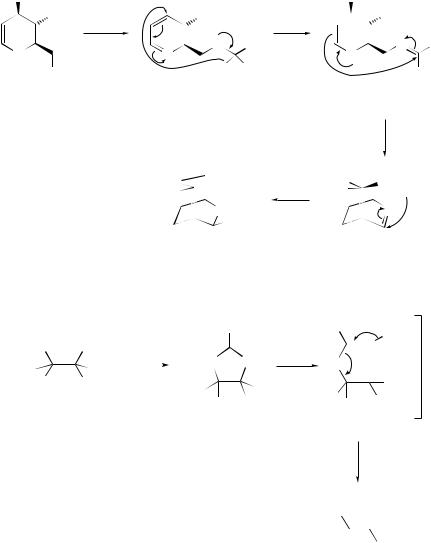
556 |
Organic Reaction Mechanisms 1998 |
OBn |
|
|
|
|
OBn |
|
|
OBn |
|
AcClO4 |
|
• • |
|
|
−BnO |
− |
+ |
Ph |
|
|
O |
|||
O |
|
O |
|
|
OBn |
|
|
H |
H |
|
|
|
|
|
|
|
|
(214) |
|
|
|
|
O |
|
|
||
|
|
|
Ph |
|
|
||
|
|
|
|
|
|
O |
OBn |
|
|
|
|
|
|
|
|
|
|
|
OBn |
|
|||
|
|
|
(217) |
|
|||
|
|
|
|
|
SCHEME 72 |
||
|
|
|
|
|
|
OR |
|
|
|
|
|
|
|
||
HO |
OH |
HC(OR)3 |
|
|
|
|
|
|
|
|
|
|
O |
O |
|
R1 |
R4 |
|
|
|
|
||
SnCl4 |
|
|
|
|
|
||
R2 |
R3 |
|
|
R |
1 |
R4 |
|
|
|
|
|
R2 |
R3 |
||
|
|
|
|
|
|
||
SCHEME 73
H
OBn
+
O Ph
O
• •
H
(215)
O |
H |
Ph |
−OBn |
|
+ |
|
O |
OBn |
|
(216) |
|
RO |
− |
O |
SnCl4 |
|
|
O |
|
+ |
R4 |
R1 R2 |
R3 |
OR4

 R3
R3
R1 R2
to yield 1-alkoxy- or 1-alkylidene-1,2,3,4-tetrahydro-9H -xanthen-9-ones and/or 3,4- dihydro-9H -xanthen-9-ones, depending on the conditions employed.347
The MNDO method has been employed348 to study the acid-catalysed rearrangement of propylene 1,2-glycol. Propanaldehyde was found to be the major product with a small amount of acetone also being produced. The solid-state pinacol rearrangement of 1,1,2-triphenylethane-1,2-diol has been performed over various solid
